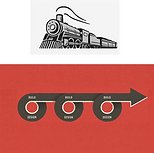

Iterative Development Model
Functionality or components are gradually developed through several loops/cycles. Each loop or cycle results in a more complete version of the product, gradually converging to the final product. This approach emphasises adaptability and the early delivery of a working product.
- Iterative development (usually performed in
Projects)

- You appoint a project leader to run the project and a steering group to
steer it.
- The steering group is cross functional and there to support the project
(they are often managers with line responsibilities but in the
steeringgroup they are there for the project)
- Iterative development is regarded as a top down method
- The project leader prioritise what are the most important requirements,
functionality or components to develop first, concentrate on them and let
the rest be.
- Evaluate on the working product, service, education, production… and
debug (the total functionality of the to be product is not there yet but it
works)
- Start a new iteration by prioritising most important requirements,
functionality or parts to develop and you start a new development loop
- This way of development is used a lot in the softwear industry.
- After a number of iterations, the to be product has the full functionality
and meets all the requirements and you can start to produce.

Iterative development Project
Presentation of Iterative development. The corresponding PPP is for sale.
Reference
By material
Menues


Main Menu
Building Block Menu

Training Menu


Assessment Menu
Coaching Menu

Company Philosophy Menu


Workshop Menu


A Human Centered Organisation
Core Human Values















